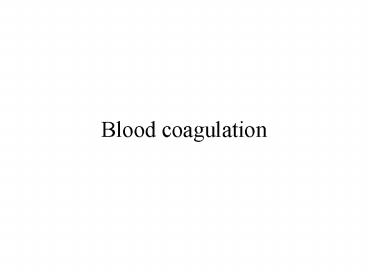Blood coagulation - PowerPoint PPT Presentation
1 / 7
Title:
Blood coagulation
Description:
Fibrinogen to Fibrin. Fibrinogen is a large heavy serum protein that is produced by the liver. ... Fibrinogen to Fibrin. Thrombin cleaves 4 low weight peptides ... – PowerPoint PPT presentation
Number of Views:90
Avg rating:3.0/5.0
Title: Blood coagulation
1
Blood coagulation
2
Blood coagulation
- Over 40 different substances that affect blood
coagulation - Procoagulants vs. anticoagulants
- Normally anticoagulants predominate in the blood
- When vessels rupture procoagulants in the area
become dominant
3
General Mechanism
- A substance or complex of substances called
prothrombin activator is formed in response to
rupture of the vessel or damage to the blood
itself. - The prothrombin activator catalyzes the
conversion of prothrombin into thrombin. - The thrombin acts as an enzyme to convert
fibrinogen into fibrin threads that enmesh
platelets, blood cells and plasma to form the
clot itself.
4
Conversion of Prothrombin to Thrombin
- Prothrombin activators form as a result of a
rupture in the blood vessel or as a result of
damage to special activator substances in the
blood
5
Prothrombin to Thrombin
- Prothrombin activators cut the large prothrombin
into the smaller active thrombin. - Prothrombin is formed continually by the liver
and is contiunally being used throughout the
body. - Lack of vitamin K or the presence of liver
disease prevents normal prothrombin formation
6
Fibrinogen to Fibrin
- Fibrinogen is a large heavy serum protein that is
produced by the liver. - Because of its large size, rarely does fibrinogen
leak into the interstitial fluids. - Trauma to the blood vessel walls allows
Fibrinogen to leak into the tissues
7
Fibrinogen to Fibrin
- Thrombin cleaves 4 low weight peptides off
fibrinogen, forming a Fibrin monomer. - Within seconds, fibrin monomers spontaniously
polymerize with other fibrin monomers forming
long fibrin threads. These threads form the
reticulum of the clot.































